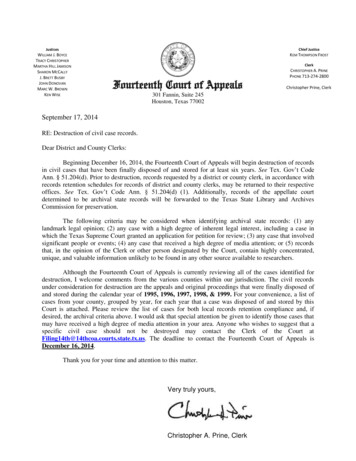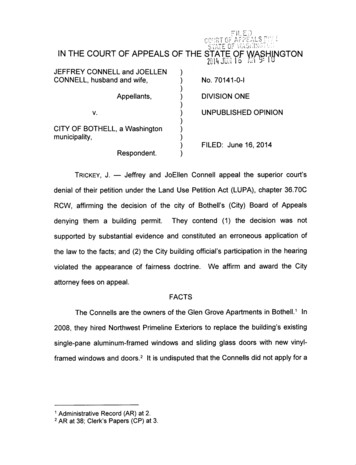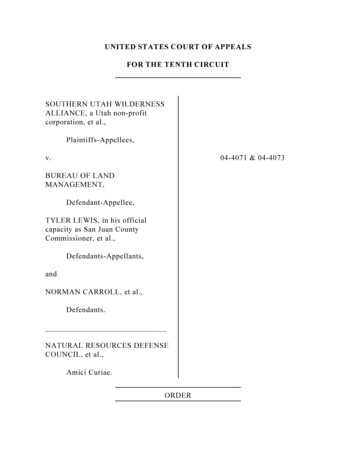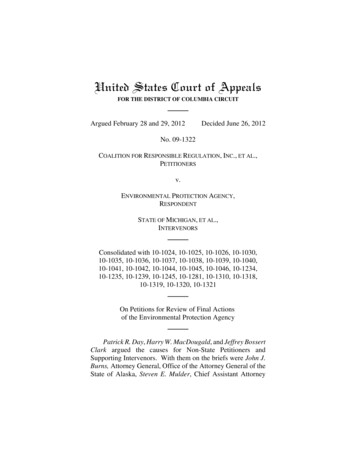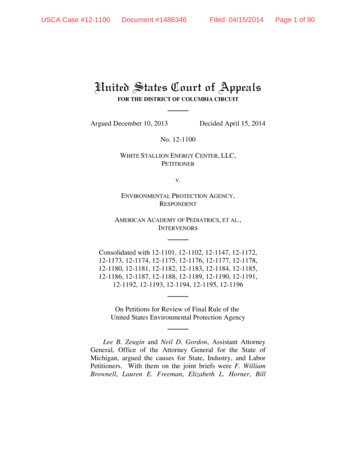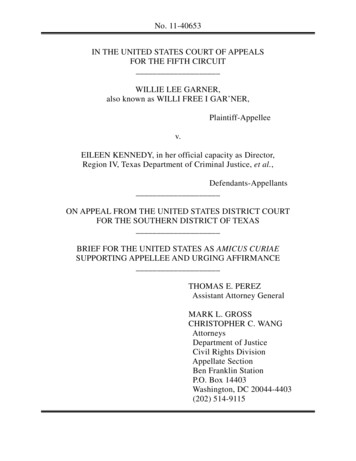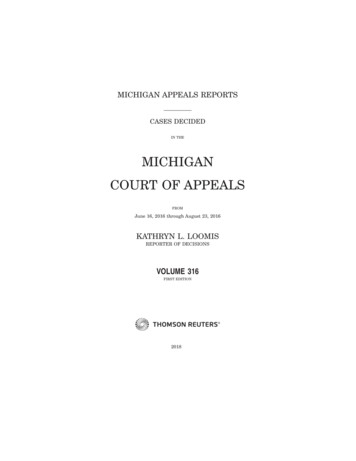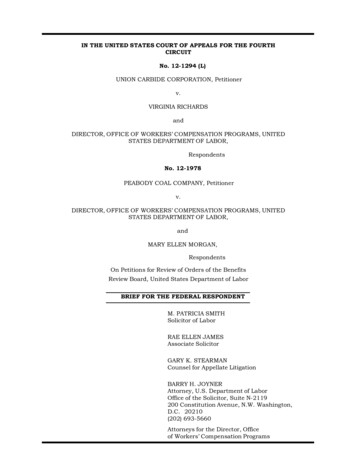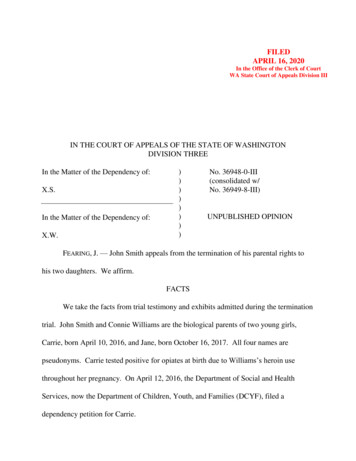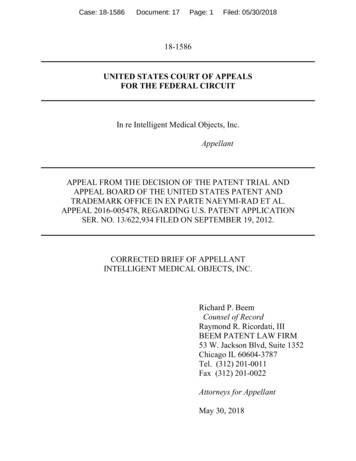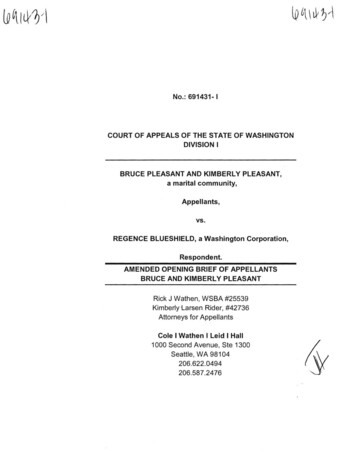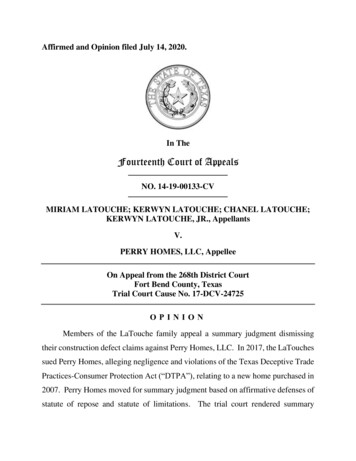
Transcription
Affirmed and Opinion filed July 14, 2020.In TheFourteenth Court of AppealsNO. 14-19-00133-CVMIRIAM LATOUCHE; KERWYN LATOUCHE; CHANEL LATOUCHE;KERWYN LATOUCHE, JR., AppellantsV.PERRY HOMES, LLC, AppelleeOn Appeal from the 268th District CourtFort Bend County, TexasTrial Court Cause No. 17-DCV-24725OPINIONMembers of the LaTouche family appeal a summary judgment dismissingtheir construction defect claims against Perry Homes, LLC. In 2017, the LaTouchessued Perry Homes, alleging negligence and violations of the Texas Deceptive TradePractices-Consumer Protection Act (“DTPA”), relating to a new home purchased in2007. Perry Homes moved for summary judgment based on affirmative defenses ofstatute of repose and statute of limitations. The trial court rendered summary
judgment without stating the basis for its ruling. Because we conclude that theapplicable statutes of limitations bar the LaTouches’ claims, we affirm the trialcourt’s judgment.BackgroundOn December 21, 2007, Perry Homes sold a newly constructed house toMiriam and Kerwyn LaTouche. That day, Miriam and Kerwyn moved into the housewith their children, Chanel and Kerwyn Jr.In December 2009, Miriam submitted a warranty request to Perry Homes. Shelisted several items in need of repair and stated additionally that she recently replacedthe carpet in the house “because I have been sick since I move [sic] in my new home.Attched [sic] are photos of my floor when the carpet was removed. I would like forsomeone to give me a call back after reviewing my photo, I have more photos ifneeded.”Miriam repeated similar complaints to Perry Homes about four years later.On May 25, 2013, Miriam spoke with a warranty representative. She said that “herfamily members have been sick and in some cases hospitalized and she thinks it isfrom the paint on the HVAC supply grills.” The next month, Miriam complained tothe representative during a meeting at the property that “the subfloor under the carpetis dirty and that dirt has been making them [the family] sick.”Three years passed.On February 17, 2016, Miriam submitted anotherwarranty request, which stated: “My Family and I have been sick since we movedinto our new home. [O]ver the past 7 years we all had health problems that we neverhad before moving to our new home. . . . [W]e feel better when we are out of ournew home than when we are in it. We strongly feel that our home is making ussick.” The family also moved out of the house on February 17. As Miriam stated2
in her affidavit, “We discovered that we generally felt better when we were notresiding in the home. We were going to and from our hotel and our home. Wediscovered that our symptoms, such as heart palpitations and headaches gotsomewhat better when we were outside the home, but returned when we got back.”Between February 2016 and July 2017, the family saw medical professionalssuch as a cardiologist, a rheumatologist, an internal medicine doctor, a neurologist,an ophthalmologist, a pulmonary care doctor, and “others.” The record does notreveal the results of these visits.In the meantime, Miriam retained a company in August 2016 to performenvironmental testing in the house.Results showed that mold was presentthroughout the house.By June 2017, the LaTouches retained counsel, who sent Perry Homes ademand letter on June 2, 2017. The demand letter asserts that “mold remediationwill be required for the entire house, to include . . . the full interior, with restorationof the house required following remediation.”The following month, in mid-July 2017, Miriam contacted Dr. ScottMcMahon in Roswell, New Mexico, who specializes in mold-based illnesses. Shescheduled a family appointment with Dr. McMahon for November 1, 2017. Duringthat appointment, Dr. McMahon diagnosed Miriam, Chanel, and Kerwyn Jr. withChronic Inflammatory Response Syndrome (“CIRS”).The next month, on December 20, 2017, Miriam filed the present lawsuitagainst Perry Homes. Miriam was the only named plaintiff at that time. Dr.McMahon subsequently diagnosed Kerwyn with CIRS on April 25, 2018. Kerwyn,Chanel, and Kerwyn Jr. joined the lawsuit as plaintiffs two days later, on April 27.The family asserted claims against Perry Homes for negligence and DTPA3
violations. They alleged that Perry Homes (1) negligently built a defective homeand (2) violated the DTPA by breaching the implied warranty of habitability,engaging in an unconscionable action or course of action, breaching the impliedwarranty of good and workmanlike performance, and making variousmisrepresentations. The LaTouches pleaded that the discovery rule applied to theirclaims.Perry Homes pleaded the affirmative defenses of statutes of limitations andstatute of repose and later moved for traditional summary judgment on both grounds.Regarding limitations, Perry Homes argued in its summary-judgment motion thatthe LaTouches’ claims were governed by two-year statutes of limitations, which hadlong expired by the time they filed suit. Perry Homes addressed the discovery ruleand argued that, as a matter of law, the rule either did not apply or, if it applied, didnot save the LaTouches’ claims because they discovered or in the exercise ofreasonable diligence should have discovered the nature of their injuries more thantwo years before filing the lawsuit. Additionally, regarding the statute of reposedefense, Perry Homes alleged that a ten-year statute of repose precluded theLaTouches’ claims.The LaTouches timely filed a response to the summary-judgment motion.They asserted that the discovery rule tolled the accrual of their claims until the familywas diagnosed with CIRS in 2017, which they asserted meant their claims weretimely filed. The LaTouches also argued that their lawyer’s June 2, 2017 letterextended the statute of repose by two years.4
An associate judge denied Perry Homes’ summary-judgment motion. PerryHomes appealed to the district judge,1 who granted the motion for summaryjudgment and dismissed the LaTouches’ claims.The LaTouches timely appealed the trial court’s ruling, challenging eachalternative ground on which Perry Homes moved for summary judgment.Standard of ReviewWe review a trial court’s ruling on a motion for summary judgment de novo.Tarr v. Timberwood Park Owners Ass’n, Inc., 556 S.W.3d 274, 278 (Tex. 2018).Courts review the record “in the light most favorable to the nonmovant, indulgingevery reasonable inference and resolving any doubts against the motion.” City ofKeller v. Wilson, 168 S.W.3d 802, 824 (Tex. 2005). A defendant moving forsummary judgment must conclusively negate at least one element of the plaintiff’stheory of recovery or plead and conclusively establish each element of an affirmativedefense. Centeq Realty, Inc. v. Siegler, 899 S.W.2d 195, 197 (Tex. 1995); Tex. R.Civ. P. 166a(c). “Undisputed evidence may be conclusive of the absence of amaterial fact issue, but only if reasonable people could not differ in their conclusionsas to that evidence.” Buck v. Palmer, 381 S.W.3d 525, 527 (Tex. 2012).When, as here, the trial court renders summary judgment without specifyingthe grounds for the ruling, we will affirm the judgment if any one of the independentsummary-judgment grounds is meritorious. See State v. Ninety Thousand TwoHundred Thirty-Five Dollars & No Cents in U.S. Currency, 390 S.W.3d 289, 292(Tex. 2013).1Tex. Gov’t Code § 54A.011.5
AnalysisPerry Homes moved for summary judgment on two grounds: (1) statute ofrepose;2 and (2) statutes of limitations. Because we determine that the statute oflimitations defense is dispositive of this appeal, we confine our opinion to thatdefense and we do not reach the other ground. See Tex. R. App. P. 47.1.A.Applicable Law Regarding Limitations and the Discovery RuleThe LaTouches asserted claims for negligence and DTPA violations.3 Theseclaims are subject to two-year statutes of limitations. See Tex. Civ. Prac. & Rem.Code § 16.003(a) (person must bring suit for personal injury not later than two yearsafter the day the cause of action accrues); Tex. Bus. & Com. Code § 17.565 (DTPAclaims must be brought within two years “after the consumer discovered or in theexercise of reasonable diligence should have discovered the occurrence of the false,misleading, or deceptive act or practice”).A statute of limitations restricts the period within which a party can assert aright, and the limitations period begins to run when the claim accrues. Landers v.Nationstar Mortg., LLC, 461 S.W.3d 923, 925 (Tex. App.—Tyler 2015, pet. denied).Generally, a claim accrues when facts come into existence that authorize a claimantto seek a judicial remedy, when a wrongful act causes some legal injury, or wheneverone person may sue another. Am. Star Energy & Minerals Corp. v. Stowers, 457S.W.3d 427, 430 (Tex. 2015).2See Tex. Civ. Prac. & Rem. Code § 16.009(a) (providing for a ten-year statute of reposefor construction defect claims).3The LaTouches contend that they also asserted a claim for breach of an express warrantyincluded in the home purchase agreement. Their live pleading does not include such a claim. Theonly allegations in the live pleading relating to a warranty are that Perry Homes breached theimplied warranty of habitability and the implied warranty of good and workmanlike performance,both of which the LaTouches asserted were actionable under the DTPA.6
One exception to the general rule of accrual is the discovery rule. Thediscovery rule is limited to those rare “circumstances where ‘the nature of the injuryincurred is inherently undiscoverable and the evidence of injury is objectivelyverifiable.’” Cosgrove v. Cade, 468 S.W.3d 32, 36 (Tex. 2015) (quoting ComputerAssocs. Int’l, Inc. v. Altai, Inc., 918 S.W.2d 453, 456 (Tex. 1996)). An injury is notinherently undiscoverable when it could be discovered through the exercise ofreasonable diligence. BP Am. Prod. Co. v. Marshall, 342 S.W.3d 59, 66 (Tex. 2011).The discovery rule defers accrual of a claim until the injured party discovered,or in the exercise of reasonable diligence should have discovered, the nature of theparty’s injury and the likelihood that the injury was caused by the wrongful acts ofanother. See Cosgrove, 468 S.W.3d at 36; Childs v. Haussecker, 974 S.W.2d 31, 36,40 (Tex. 1998); B. Mahler Interests, L.P. v. DMAC Constr., Inc., 503 S.W.3d 43, 49(Tex. App.—Houston [14th Dist.] 2016, no pet.). The rule expressly requires aplaintiff to use reasonable diligence to investigate the nature of the injury and itslikely cause once the plaintiff is apprised of facts that would make a reasonablydiligent person seek information. See Childs, 974 S.W.2d at 47. It is the discoveryof the injury and its general cause, not discovery of the exact cause in fact, that startsthe running of the limitations period. Bayou Bend Towers Council of Co-Owners v.Manhattan Constr. Co., 866 S.W.2d 740, 743 (Tex. App.—Houston [14th Dist.]1993, writ denied). “Knowledge of injury initiates the accrual of the cause of actionand triggers the putative claimant’s duty to exercise reasonable diligence toinvestigate the problem, even if the claimant does not know the specific cause of theinjury or the full extent of it.” Exxon Corp. v. Emerald Oil & Gas Co., 348 S.W.3d194, 209 (Tex. 2011).Generally, when a plaintiff discovers or should have discovered the cause ofthe injury and whether a particular plaintiff exercised due diligence in so discovering7
the injury are fact questions. See Childs, 974 S.W.2d at 44; Wheeler v. MethodistHosp., 95 S.W.3d 628, 637 (Tex. App.—Houston [1st Dist.] 2002, no pet.).However, if reasonable minds could not differ about the conclusion to be drawn fromthe facts, the commencement of the limitations period may be determined as a matterof law. Childs, 974 S.W.2d at 44. A defendant moving for summary judgment onthe affirmative defense of limitations bears the burden of conclusively establishingthe elements of that defense. Schlumberger Tech. Corp. v. Pasko, 544 S.W.3d 830,833 (Tex. 2018) (per curiam). This burden includes conclusively establishing whenthe claim accrued. Id. at 833-34. In cases in which the plaintiff pleads the discoveryrule, the defendant moving for summary judgment on limitations bears the additionalburden of negating the rule. Id. at 834; Childs, 974 S.W.2d at 44. Defendants maymeet this burden by either conclusively establishing that (1) the discovery rule doesnot apply, or (2) if the rule applies, the summary-judgment evidence shows nogenuine issue of material fact about when the plaintiff discovered, or in the exerciseof reasonable diligence should have discovered, the nature of the injury. See RhonePoulenc, Inc. v. Steel, 997 S.W.2d 217, 223-24 (Tex. 1999); Childs, 974 S.W.2d at36; Pirtle v. Kahn, 177 S.W.3d 567, 572 (Tex. App.—Houston [1st Dist.] 2005, pet.denied).Once the defendant produces evidence sufficient to establish the right tosummary judgment, the burden shifts to the plaintiff to come forward withcompetent controverting evidence that raises a fact issue as to one element of thedefendant’s affirmative defense. Amedisys, Inc. v. Kingwood Home Health Care,LLC, 437 S.W.3d 507, 511 (Tex. 2014). If the movant does not satisfy its initialburden, however, the burden does not shift, and the nonmovant need not respond orpresent any evidence. Id. at 511-12.8
B.ApplicationIn its motion for summary judgment, Perry Homes raised two generalarguments regarding limitations and the discovery rule. First, Perry Homes arguedthat the discovery rule did not apply because the alleged injuries are not inherentlyundiscoverable. Second, assuming the discovery rule applies, and based on theLaTouches’ repeated assertions, beginning in December 2009, that the house madethem sick, they knew or through reasonable diligence should have known of thenature of their injuries long before they filed suit. According to Perry Homes,waiting until 2017 to file suit was too late because the LaTouches were aware offacts as early as 2009 that would cause reasonable people to diligently seekinformation about their illnesses and likely causes. Perry Homes cited Pirtle insupport of its argument.In response, the LaTouches argued that the discovery rule applied and thatPerry Homes failed to establish that the family’s claims accrued earlier than twoyears before filing suit. In particular, the LaTouches asserted that Perry Homes’evidence does not establish as a matter of law that the LaTouches’ “sickness fromthe dirty carpets and subfloor had any relation whatsoever to the CIRS Plaintiffswere eventually diagnosed with.”The latest action by Perry Homes of which the LaTouches complain occurredin December 2007, when the company completed construction of the house. Underthe general rule of accrual, the applicable two-year limitations periods expired inDecember 2009—well before Miriam first filed suit against Perry Homes inDecember 2017. Perry Homes’ evidence established the accrual date under thegeneral rule. Thus, absent tolling, the LaTouches’ claims are barred by limitations.Because the LaTouches invoked the discovery rule, we consider whether thelimitations period was tolled and, if so, whether it was tolled for a sufficient length9
of time to render the LaTouches’ claims timely filed.4 We first consider Miriam’sclaim because she was the first to file. Miriam filed her lawsuit on December 20,2017. For Perry Homes to be entitled to summary judgment on limitations grounds,the record must show conclusively that Miriam’s claims accrued before December20, 2015. To answer the question we must consider whether Miriam discovered, orin the exercise of reasonable diligence should have discovered before December 20,2015, the nature of her injury and the likelihood that it was caused by the wrongfulacts of another. See Childs, 974 S.W.2d at 40.Miriam first told Perry Homes in December 2009 that she had been sick sinceshe moved into the house, and she at least implied to Perry Homes at that time thatthe cause of her illness was related to the carpet or something under the carpet. Morethan three years later, in May and June 2013, Miriam complained to a Perry Homeswarranty representative that “her family members have been sick and in some caseshospitalized,” and that she believed their sickness was caused by the subfloor or thepaint. After another three years passed, Miriam yet again asserted to Perry Homesthat the entire family had been sick since moving into the house. She stated in herFebruary 2016 warranty request: “My Family and I have been sick since we movedinto our new home. [O]ver the past 7 years we all had health problems that we neverhad before moving to our new home. . . . [W]e feel better when we are out of ournew home than when we are in it. We strongly feel that our home is making ussick.” According to the uncontroverted evidence Perry Homes presented, Miriamknew she was sick as early as 2008 (shortly after she moved into the house), that herThe parties dispute whether the LaTouches’ alleged injuries are inherentlyundiscoverable, and thus whether the discovery rule applies. For argument’s sake, we presumewithout deciding that the discovery rule applies to the circumstances presented. See Hennen v.McGinty, 335 S.W.3d 642, 650 (Tex. App.—Houston [14th Dist.] 2011) (assuming withoutdeciding discovery rule applied), rev’d on other grounds, 372 S.W.3d 625 (Tex. 2012) (percuriam).410
sickness persisted until she vacated the house in 2016, that she told Perry Homes inDecember 2009, May 2013, June 2013, and February 2016, that she believedsomething in the house was responsible for her illness, and that by June 2013 at leastone or more family members had been hospitalized due to the illness she attributedto the house.Perry Homes relies heavily on Pirtle, a case in which a tenant sued herlandlord for personal injury damages after the tenant allegedly contracted a moldinduced illness. See Pirtle, 177 S.W.3d at 570. The tenant had become sick shortlyafter moving into her apartment and was diagnosed with various ailments over thenext several years. Id. at 569. A number of years later, the tenant noticed a leak inthe ceiling and found mold. Id. In her deposition, the tenant stated that she had a“major revelation” when she found the mold and that “I was delighted to have founda leak because I believed that was why—that made sense to me that my health hadbeen absolutely deteriorating since the moment I moved in there.” Id. at 569-70.The tenant did not sue the landlord until almost eight years had passed aftermoving into the apartment and more than three years after she found the mold. Id.at 570. The landlord asserted a limitations defense, arguing that the tenant’s claimsaccrued when she moved into the apartment or, at the latest, when the tenant foundmold. Id. at 570, 572. The tenant, on the other hand, contended that her claims didnot accrue until she received the results of environmental mold tests and wasdiagnosed with mold-related illnesses. Id. at 572. The court of appeals held that thetenant was on notice, as of the date she found mold, of facts that would cause areasonable person to make inquiries sufficient to discover the claims. Id. at 573.From that date, the tenant’s personal-injury claims were subject to a two-yearlimitations period, but the tenant did not file her lawsuit until more than three years11
later. Id. at 573-74. Accordingly, the court concluded that the tenant’s personalinjury claims were barred by limitations. Id.Though Miriam did not discover the specific problem of mold in the housebefore December 2015, Pirtle is nonetheless supportive of Perry Homes’ argument.Miriam experienced a relatively quick onset of symptoms, which she repeatedlybrought to Perry Homes’ attention through a series of complaints that spanned years.Perry Homes’ uncontroverted evidence is sufficient to establish that—as early asDecember 2009 and by June 2013 at the latest (when at least one or more familymembers had been hospitalized)—Miriam had a duty of reasonable di
On December 21, 2007, Perry Homes sold a newly constructed house to Miriam and Kerwyn LaTouche. That day, Miriam and Kerwyn moved into the house with their children, Chanel and Kerwyn Jr. In December 2009, Miriam submitted a warra
